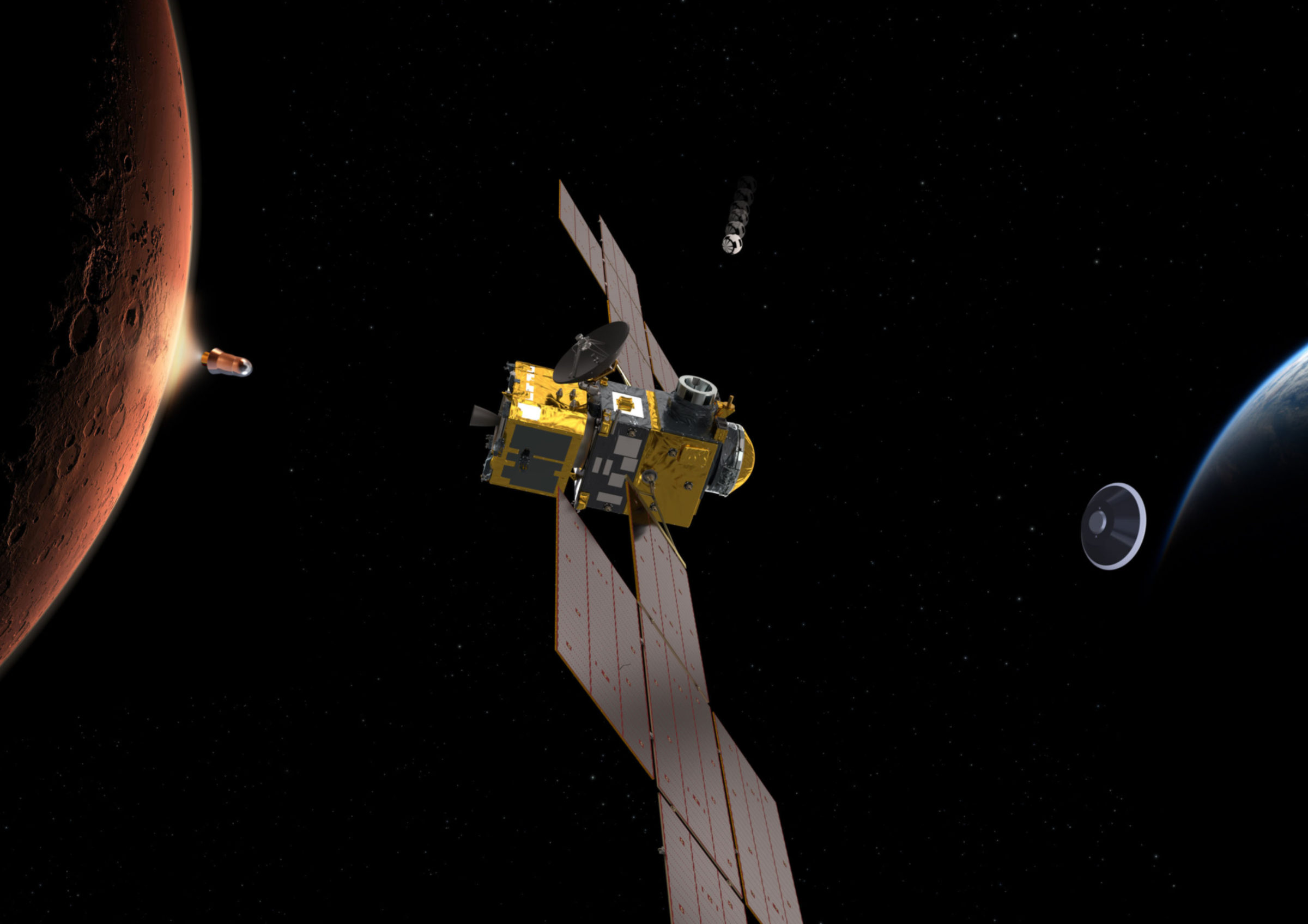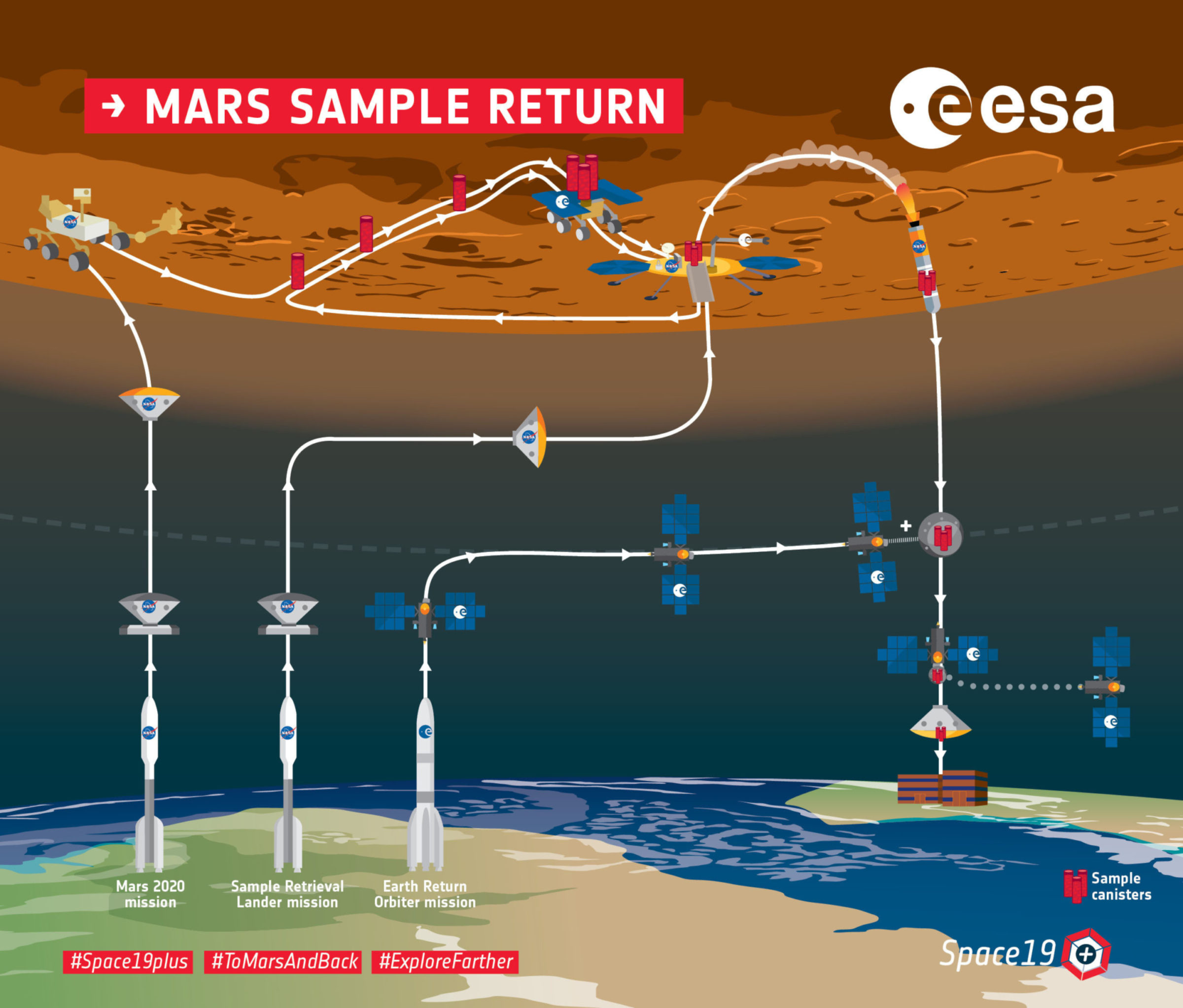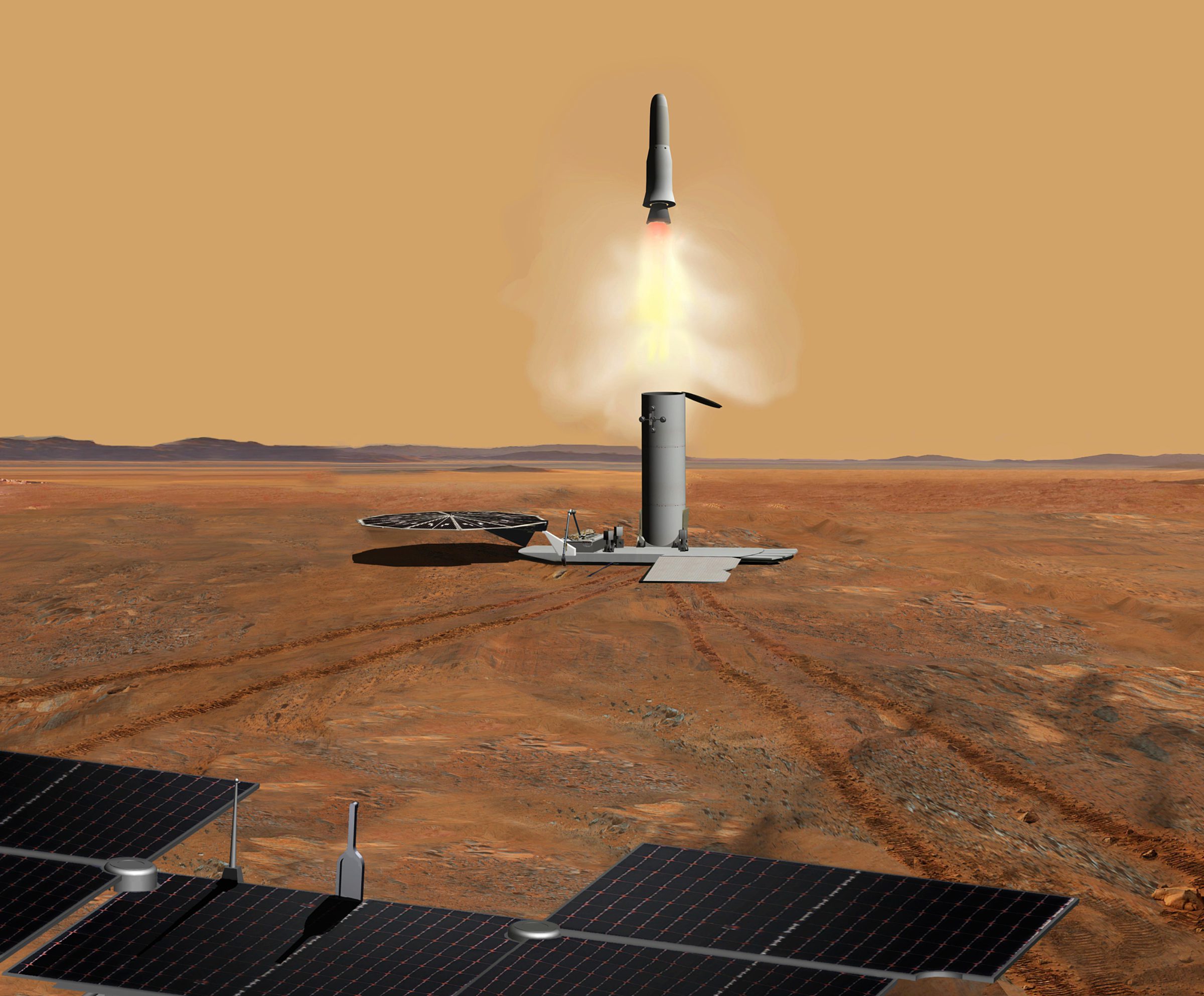Justin Cowart • Aug 13, 2019
NASA, ESA Officials Outline Latest Mars Sample Return Plans
Last week, scientists gathered at Caltech for the Ninth International Conference on Mars. This conference, which takes place at intervals of several years (the eighth was in 2014), provides an opportunity for the Mars community to summarize the state of science and identify pressing future research questions and techniques.
A special plenary session on Mars sample return (MSR) on 24 July featured representatives from NASA, the European Space Agency (ESA), and the Canadian Space Agency (CSA). Additional information on the MSR program was provided by Jim Watzin (NASA Mars Exploration Program Director) at the 37th Mars Exploration Program Analysis Group (MEPAG) meeting on 26 July. Together these presentations provided the Mars community with their first detailed glimpse of the current MSR mission architecture and timeline.
The current strategy for MSR is an international mission with primary mission hardware provided by NASA and ESA. Additional international support for the mission is being solicited, but these collaborations are still in early negotiations. According to JPL’s Chad Edwards, the goal was to “break up the mission into affordable, technically achievable, cleanly-defined segments,” adding “nothing needs a technological miracle to make this happen.” The mission segments consist of the Mars 2020 rover, a solar-powered surface retrieval lander and rover mission jointly developed between NASA and ESA, and a sample return orbiter built by ESA with NASA contributions. NASA provided input on ESA’s Earth return orbiter and sample retrieval rover design studies, while ESA provided input on updates to the general sample retrieval lander design concept. Watzin noted the crucial importance of this international collaboration, saying “it’s important that if this mission is to succeed that NASA and ESA work as one big team.”
Both the Earth-return orbiter (ERO) and sample retrieval lander/fetch rover (SRL) will depart Earth in 2026, in different months.

Launching Mars 2020’s Samples into Space
The surface retrieval lander will launch in July 2026. Those familiar with Mars exploration travel opportunities may realize July is well before the typical low-energy transfer window that opens in October 2026. However, a direct flight from Earth in 2026 places the lander on the surface in August 2027. This coincides with Mars’ northern late summer, a time of year notorious for large dust storms which could be fatal for a solar-powered retrieval lander and rover.
Instead, the lander will take an unusual “long track to Mars”, in the words of Chad Edwards. After launch, the lander will orbit the Sun 1.5 times, arriving in August 2028, around the time of Mars’ northern spring equinox. Dust lifting is at a minimum at this time of year, allowing the lander and rover to perform retrieval operations with a very low probability of encountering a mission-ending dust storm. The lander will either use a beefed-up version of the propulsive platform used by the Mars Polar Lander, Phoenix, and InSight missions, or employ a version of the Curiosity and Mars 2020 descent stage (colloquially known as Skycrane). While a decision is not yet final, Edwards mentioned that the propulsive platform was the currently favored option.
Editor's note: ESA reports they are continuing to have challenges with the parachute system for their ExoMars 2020 mission, which could have implications for the surface retrieval lander.
Once on the surface, the lander will deploy the fetch rover, which will collect the samples cached by Mars 2020 and return them to the lander over a six-month period of operations. The lander will load the samples into a basketball-sized orbital module and seal it for launch. As currently envisioned, the lander has no capability to collect a contingency sample from the surface in case of a failure in the fetch rover. Instead, the plan is for the sample retrieval lander to arrive while Mars 2020 is still operational, meaning it could receive samples directly from that rover, if necessary.
Once all samples are retrieved, the rover will launch them into orbit using a deck-mounted rocket. This rocket’s design has not been finalized, but NASA is weighing a 2-stage solid rocket or a single-stage hybrid rocket as options.
Bringing Them Home
While the sample retrieval lander architecture is still sketchy, the Earth-return orbiter is much better developed. According to NASA’s Jim Watzin, ESA spent much of 2018 and 2019 performing design concept studies for the return orbiter. In addition, ESA released an invitation to tender on 23 July, beginning the competitive bidding process for the spacecraft’s construction. According to ESA’s Jakob Huesing, the orbiter will consist of a chemically-powered orbital insertion module and ion-propelled main module built by ESA. NASA will build the orbiter’s sample capture mechanism and Earth reentry capsule. The orbiter will be very large; to power its ion propulsion system the solar array will measure 40 meters wingtip to wingtip. This array will be capable of generating 40 kW of power. (This is slightly larger than previous ESA missions; Rosetta’s panels spanned 32 meters.)
The return orbiter is planned to follow a traditional, direct-to-Mars trajectory that departs Earth in October 2026 on an Ariane 6 booster. Its expected arrival at Mars is anything but traditional, however, as it can’t carry enough fuel to enter its operational orbit using chemical propulsion. Instead, it will follow a multi-step process using both chemical and ion propulsion. Upon Mars arrival, the orbiter will enter a highly elliptical orbit using a chemically powered orbital insertion module. Then it will jettison the orbital insertion module to reduce mass and spend the next year lowering itself into its operational orbit using the ion propulsion system. It will arrive in its final orbit in July 2028, just in time for use as a relay for Mars 2020 and the sample retrieval lander as retrieval operations begin.
The sample return canister will launch in spring 2029. The Earth-return orbiter will spend up to 6 months locating the basketball-sized return canister via optical tracking. Once located, the orbiter will maneuver into position to catch the canister within the capture mechanism, which will trap and orient the canister for loading into the Earth entry module. After the Earth entry module is loaded and sealed, the orbiter will jettison the capture mechanism and spend the next year raising itself out of Mars orbit using ion propulsion. ERO is targeting a Mars-to-Earth return window in 2031.
The mission’s final phase will occur in spring 2032. The Earth-return orbiter will aim at a landing zone, eject the module, and then perform an Earth avoidance maneuver that will permit it to fly safely by. The sample module’s landing site has not been selected, but NASA’s working assumption is that the landing will occur at the Utah Test Range, where both Genesis and Stardust dropped their sample canisters.
A successful Mars sample return would be the first time we have retrieved a sample that carried the possibility of contaminating Earth with alien microbes. That possibility makes it a “restricted sample return.” The Earth return module was originally designed to land intact in the event of a parachute failure. This design has since evolved to feature no parachute at all. Jim Watzin noted that the mission was operating on very tight mass constraints, so eliminating the parachute frees up critical mass. NASA has already begun performing drop-tests to refine a possible sample return probe; data from these drop tests were used in the design of the Mars 2020 sample tubes to help them survive landing intact. Chad Edwards described the landing in his talk, indicating that the samples would only experience “the same amount of force as dropping your cell phone off the table” during landing.

International Collaboration
Planning for the current iteration of Mars sample return began in 2016 with high-level negotiations between NASA and ESA. During this process, the two agencies dusted off previous mission concepts and converged on a plan affordable for both agencies. This process concluded with the signing of a joint NASA/ESA Statement of Intent at the Berlin Airshow in April 2018, allowing the space agencies to begin developing the “business plan” to their respective governments.
In the following months, NASA assigned responsibilities to its various spaceflight centers, but detailed architectural studies could not begin until the FY2019 budget appropriations allocated money to the project. ESA used this time to commission 2 design studies for the Earth-return orbiter and an additional 2 design studies for the surface retrieval rover. Watzin said he was “pleased and impressed with how aggressively ESA has pursued this project”.
NASA has been rushing to make up for the delay since the FY2019 budget was approved in March. On 12 July, NASA formally approved the roles and responsibilities in the joint collaboration with ESA, essentially finalizing the overall mission structure. Two critical final budgetary steps remain. On the ESA’s side, a Ministerial Council meeting will take place on 26-28 November to approve the proposed budget for the Earth-return orbiter. On NASA’s side, its FY2020 budget requested money to finalize the mission architecture design with the goal to begin sample retrieval lander development in FY2021.
Pressure on Other Mars Missions
The scale of the project has led to some concerns among NASA’s Mars research community. The concern most frequently voiced during the plenary session and subsequent MEPAG meeting was its effect on the rest of the Mars program. NASA’s Mars fleet is aging. The two spacecraft that support all surface research by performing relay communications, Mars Odyssey and Mars Reconnaissance Orbiter, have been operating in Mars orbit for 18 years and 13 years, respectively. Odyssey is expected to run out of propellant by 2025, and the condition of Mars Reconnaissance Orbiter’s batteries could end its operations as early as the mid-2020s.
The cost of Mars sample return would likely prevent a follow-on to either of these Mars-orbiting missions until after the samples are returned to Earth in 2032. That would shunt the bulk of surface relay onto NASA’s MAVEN and ESA’s Trace Gas Orbiter, adversely affecting the research capabilities of those missions. MAVEN has completed its primary mission and Trace Gas Orbiter will complete its own at the end of 2019. Although both missions have always expected to spend significant resources performing data relay during their extended missions, both have encountered more complex environments than originally expected. A major concern voiced by the Mars community was that the need to move these missions to rover support would negatively impact these missions’ own exploration. Indeed, Trace Gas Orbiter is already handling 60% of Curiosity’s data return, according to ESA’s Jorge Vago.
There is the possibility of a Mars orbiter mission being prioritized for a future Discovery or New Frontiers mission to alleviate pressure on MAVEN and Trace Gas Orbiter. However, such an orbiter would have to compete with the rest of NASA’s science program for funding. Given NASA’s recent push towards asteroids and icy bodies with these programs, that competition is likely to be stiff. The Mars science community expressed a lot of pessimism regarding the chances of funding such missions, given the large amount of money already directed towards the Mars program and Mars sample return. Scientists with interests beyond the Mars program also fretted that a Mars orbiter mission in addition to Mars sample return would further delay exploration of other high-priority targets within the Solar System.
In addition to relay, Mars Reconnaissance Orbiter provides another surface on which landed missions depend. It carries MARCI, currently the only camera capable of providing daily weather maps of the entire surface. These maps are used to plan power budgets for solar-powered missions and scale operations accordingly. The timeline outlined above would see sample retrieval surface operations begin as Mars Reconnaissance Orbiter reaches the limits of its design life, meaning there is a strong possibility that sample retrieval would be taking place without global weather monitoring. Landing outside of the historical dust season mitigates the hazard, but this year’s dust activity shows the risks of relying on average conditions for predicting seasonal behavior. Claire Newmann (York University) pointed out that local- and regional-scale dust storms following the massive Mars year 34 dust storm (which killed Opportunity in 2018) continued well into the spring of the following Mars year, which would have adversely affected SRL’s operations had it been operating under this year’s conditions.
Failing to replace Mars Reconnaissance Orbiter’s weather monitoring capabilities would also create a gap in observations of Martian climate conditions, which have been continuous since Mars Global Surveyor’s arrival in 1997. A major research goal identified during the Ninth International Conference on Mars was forecasting Martian dust storms and predicting whether they could expand into global events. The loss of Mars Reconnaissance Orbiter’s weather mapping capabilities without a replacement mission would create a gap in Martian climatological records lasting as long as a decade.
Finally, there is some concern regarding how Mars sample return could affect the pace of Mars 2020 operations in Jezero Crater. Mars 2020 deputy project scientist Katie Stack Morgan described an aggressive pace of operations that includes the collection of 20 samples from 7 different geological units and an approximately 10-kilometer traverse from the landing site to the Jezero Crater rim by the end of the baseline mission in 2023. This pace is dictated by the arrival of the sample retrieval lander in 2028 and the desire to send Mars 2020 to collect some samples from the Midway landing site.
Midway is described as a “stretch goal” for the 2020 rover, an opportunity to see and sample a different suite of geologic materials that is available within Jezero crater. Jezero is primarily a delta environment, while the Midway site contains materials that originated deep in Mars’ crust that were excavated by the Isidis impact. If the Mars 2020 rover were to travel to Midway, it could visit two very different geological environments with one mission.
The sample retrieval lander can only land safely at either the Jezero or Midway landing sites developed for Mars 2020.The 2020 rover’s traverse to Midway is expected to take around 5 years, meaning that if it is to reach Midway in time to meet the sample return mission, Mars 2020 will need to depart Jezero by 2023. ASU’s Steve Ruff voiced his concern that attempting to make a 2023 departure date from Jezero would severely compromise the scientific goals of Mars 2020. The pace of the mission as planned dictates that Mars 2020 average one sample a month, limiting the amount of time available to evaluate the most useful sampling locations and to characterize the local environment of the samples.
JPL’s Ken Williford, another deputy project scientist for the 2020 rover, described the mission team’s approach to mitigate this issue. The rover’s operators have been participating in a series of preparation activities called ROASTT (Rover Operations Activities for Science Team Training), which spent “lots of time and effort practicing at the ambitious science goals to hit the ground running.” The first ROASST activity took place in 2018, with operators meeting to strategize for their traverse and work out the broad scale of the sampling campaign. A second ROASST activity took place this year, simulating the science campaign and giving the team a chance to practice tactical operations. A final ROASST activity is planned early next year, emphasizing sample decision-making. Ken Williford described the final ROASST activity in Kenny Rogers lyrics, saying rover scientists “gotta know when to hold ‘em.”
However, another recurring theme of the Mars conference was the inability of remote sensing to see everything at the surface. As experience with previous Mars rovers has shown, the geology on the ground has always been more complex than what has been observed from orbit. Previous experience with traverse planning during the Apollo missions also highlighted the tight constraints that highly-structured traverses place on investigating the unexpected. The geology of Jezero Crater is undoubtedly complex and there is a good chance that Mars 2020 will come across at least one unexpected discovery. These discoveries take time to understand, and the rush to position the rover for a possible traverse to Midway might prevent the mission from obtaining the data necessary to understand what the rover is seeing.
The MSR program represents a highly ambitious project, with the potential to fulfill a goal that NASA has been pursuing on and off since the 1960s. Momentum has been building for nearly two decades, and it is looking like a more reachable goal than it has in a long time. If it does proceed, will it unlock transformation in our understanding of Mars, or begin a decades-long dark age in Mars science?
Support our core enterprises
Your support powers our mission to explore worlds, find life, and defend Earth. You make all the difference when you make a gift. Give today!
Donate

 Explore Worlds
Explore Worlds Find Life
Find Life Defend Earth
Defend Earth


